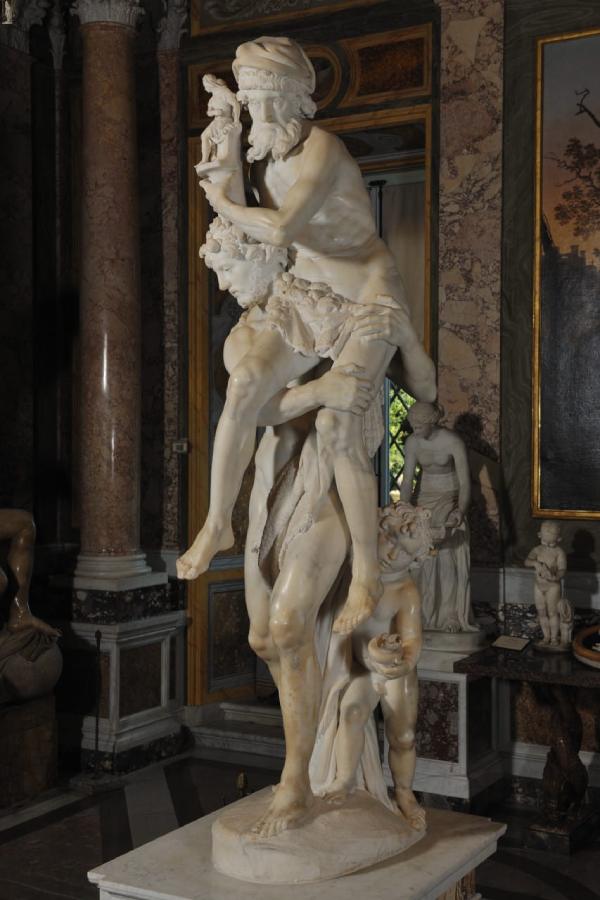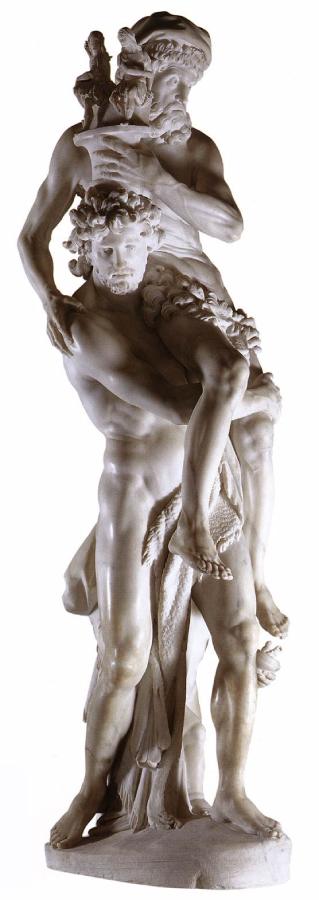Bernini, Gian Lorenzo (1598-1680)
Enea, Anchise e Ascanio (Aeneas, Anchises, and Ascanius)
1619
Marble, h. 220 cm
Galleria Borghese, Roma
This is the first large sculpture group produced by Gian Lorenzo Bernini for Scipione Borghese, for which a payment receipt dating to 1619 has come down to us. The work depicts Aeneas, Anchises and Ascanius fleeing from Troy in flames, the episode described by Virgil in the second book of the Aeneid. The work presented the patron with the opportunity of expressing a historical, theological and celebratory message: transferred from Troy to Rome through Aeneas, the imperium subsequently passed to the Church and the pope; here it would be exercised thanks to the support of the young cardinal-nephew Scipione.
The group also represents the traditional theme of the three ages of man, which is reinforced by the varied treatments of the respective surfaces of the bodies of the protagonists: the soft flesh of the child contrasts with the taut skin of the adult, which in turn differs from the withered external appearance of the old man.
The group depicts Aeneas, Anchises and Ascanius fleeing from Troy in flames. Aeneas carries his elderly father on his shoulders. Ascanius wears a Phrygian cap and holds the rescued statuette of the Penates on Aeneas’s head with his left hand while balancing himself on his son’s shoulder with his right. Aeneas uses both hands to hold the left leg of Anchises, whose right leg falls freely in front of his son’s chest, creating an elegant intertwining of limbs. The young Ascanius looks out timidly from behind them, carrying the sacred fire of Vesta in his hand. The three naked figures are partially covered by a fur.
As in his other works, here Bernini envisioned a viewpoint that favoured the front and right side of the group, as is evident from the various parts which the sculptor left unfinished, on the assumption that they would not be visible from that angle (Chilosi, in Bernini scultore, 2002, p. 125).
This is the first large sculpture group produced by Gian Lorenzo Bernini for Scipione Borghese, for which a payment receipt dating to 1619 has come down to us (Faldi 1954, p. 28). The discovery of this document put an end to the long debate over the sculpture’s attribution, which began as early as the 17th century with Sandrart, who maintained that the work was executed in collaboration with Gian Lorenzo’s father Pietro. A second receipt for payment made to the carver for the base of the sculpture likewise dates to 1619.
Taken from the second book of Virgil’s Aeneid, the subject also expresses a historical and theological message: transferred from Troy to Rome through Aeneas, the imperium subsequently passed to the Church and the pope; here it would be exercised thanks to the participation of the young cardinal-nephew. For this reason, Bernini wished to represent Aeneas as the young Scipione, who supports his aged uncle, the pope: scipio in Latin in fact refers to the walking stick used by the elderly (D’Onofrio 1967, p. 228ff.).
The group was originally placed in Room 3 of Villa Pinciana (Manilli 1650, p. 69); here it remained until 1832, as we know from Montelatici’s account, from 18th-century inventories of the Collection and from Nibby’s reference to the work (1832, pp. 84-6). Later it was moved to the first floor (today’s Room 14) and then to the Entrance Hall. In 1888, it was definitively positioned in the centre of Room 6, replacing the famous Gladiator sculpted by Agasias of Ephesus in the 1st century BC, which had been transferred to Paris in 1808.
The original support for the group was a cylindrical base decorated with garlands and bucrania; taken from an ancient altar, the base still forms part of the Borghese Collection (inv. no. LXVI). It was replaced in the 19th century with a wooden base, which in turn made way for the current marble pedestal, carved by Pietro Fortunati.
From an iconographic point of view, the work which most closely resembles our group is the Flight from Troy by Ludovico, Annibale and Agostino Carracci, displayed in the Aeneid Room in Palazzo Fava in Bologna. This canvas represents the scene from a lateral view, with Aeneas carrying Anchises on one shoulder only: this motif contrasts with other representations of the subject, such as that by Raphael in the Room of the Fire in the Borgo in the Vatican, in which Aeneas carries his elderly father on his back. In Raphael’s painting Anchises is shown carrying the Trojan Penates, depicted according to the description of Dionysius of Halicarnassus, namely ‘two young men seated with a lance’ (Weinstock, RE 19, 1, 1937, col. 449).
The group further represents the traditional theme of the three ages of man, which is given emphasis by the varied treatments of the respective surfaces of the bodies of the protagonists: the soft flesh of the child contrasts with the taut skin that reveals the muscles of the adult, which in turn differs from the withered external appearance of the old man. The figure of Anchises, whose leg is paralysed and whose back is bent from age, competes with several realistic images of elderly men found in contemporary paintings, such as Caravaggio’s Saint Jerome, which also formed part of the Scipione’s collection. The figure of Aeneas, finally, appears to be the mirror image of Michelangelo’s Christ in the Roman church of Santa Maria sopra Minerva (Minozzi, in Bernini 2017, p. 158). (GB)
See also:
• Virgil (70 BC-19 BC): The Aeneid (English)

